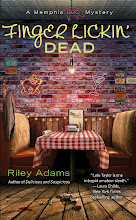by Elizabeth S. Craig, @elizabethscraig.
 I’m currently reading a mystery (no surprise there) that I’m really enjoying: Death of a Cozy Writer by G.M. Malliet.
I’m currently reading a mystery (no surprise there) that I’m really enjoying: Death of a Cozy Writer by G.M. Malliet.
One thing I love as a mystery reader is finding clues to a character’s personality, talents, or weaknesses.
One of the characters in the book, Albert, (no spoilers, I promise), is a major alcoholic. His siblings talk about how much he drinks, and he’s portrayed as inebriated at every meal and even in the mornings.
Another character, Jeffrey, is mulling over people he’s recently met, one of them Albert. He thinks that:
…he rather had the idea Albert drank.
This made me laugh at the understatement and the general cluelessness of the character. It also gave me an important insight into Jeffrey’s character—he’s not observant. In a mystery, this means that his impressions of other characters/suspects in the book might not be accurate.
I’m not a fan of reading info dumps. An author could describe a character with well-written, vivid details and I’ll going to skim it. I’m usually more interested in picking up on little details that point to qualities the character has. Or a slipped-in description—a character whose shoulders are stooped from listening to shorter people around him. Or the character with lots of smile lines and raven’s feet….sort of a double-duty description. Cheerful and wrinkly!
With indirect characterization, you let the reader draw their own conclusions: based on character dialogue, internal musings shared with the reader, and other characters’ observations about a character. Then the readers can pick up the hints and feel clever about their deductions.
For instance, we can show one character’s demeanor when dealing with the protagonist—and add dialogue clues to hint at character traits and the characters’ relationship with each other.
You could have a character that you want to portray as someone who talks too much. This could easily be expressed by interruptions from a second character or their signs of impatience. Or of them putting off a phone call with the character. Much better than pages and pages of chatty dialogue to prove the point.
Since I’m a mystery writer, I’m also interested in planting the wrong impression of a character. I might mislead the reader. (Other novelists might want to do the same thing, for different reasons.) Maybe the character is unnaturally chatty because they’re nervous. Maybe the second character is just an impatient person who interrupts—maybe they’re not making a point about the character’s loquaciousness at all.
Do you enjoy leaving clues to your characters’ personalities and appearance?
Image—Flickr—Brian D. Perskin













